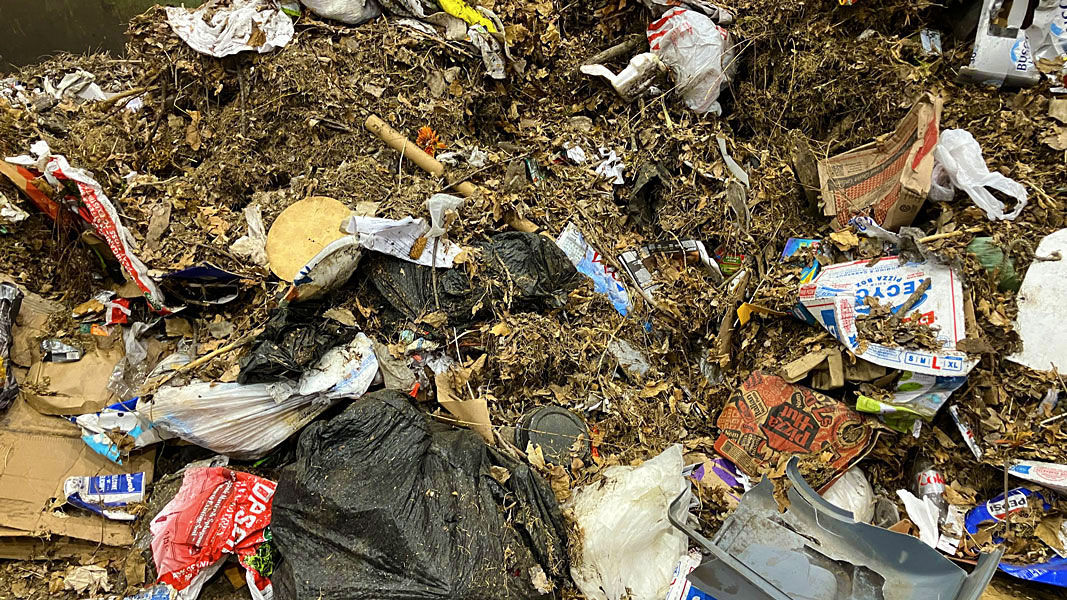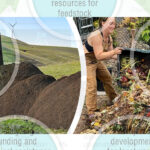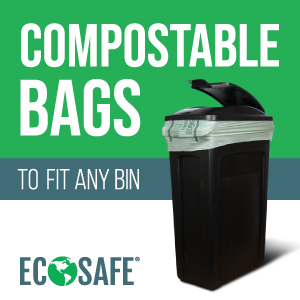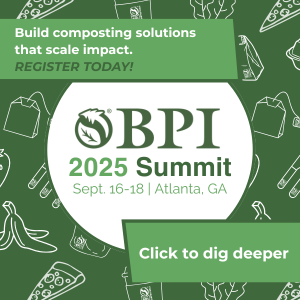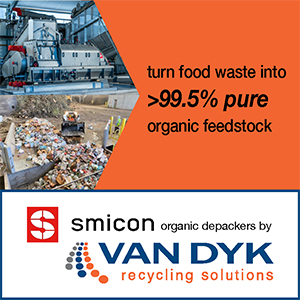Top: Hutchinson’s program faced two major problems: contamination rates that had crept up over the years and declining set out rates. Photos courtesy of Amplify for Change
Mimi Shah and Betsy Lipson
In our work at Amplify for Change, we rarely get the call when everything is going smoothly. Municipalities bring us in when they want to start a program or when their food scraps collection programs are struggling — most often with contamination. That vantage point means we see, over and over again, the direct link between program design and program success. If you don’t get your program’s structure right (see Part I), no amount of good intentions from residents will overcome it.
The City of Hutchinson, Minnesota, is a prime example. Its source separated organics program has been around since 2000 — longer than most in the country — and serves over 4,000 single-family households. Residents can put both food scraps and yard trimmings into a curbside cart for weekly pickup. The material goes to Creekside Soils, the municipally-owned composting facility, where it’s processed and bagged for sale.
The Playbook
Despite its long history, Hutchinson’s program faced two major problems: contamination rates that had crept up over the years and declining set out rates. A typical load in 2022 contained plastics, metals, glass, and other non-compostables in plain view.
That year, the City, Creekside Soils, Amplify for Change (Amplify), and Coker Composting and Consulting — supported by a grant from the Minnesota Pollution Control Agency — launched “Compost It Right!”, a targeted program to turn things around. Three years later, Hutchinson has successfully reduced contamination and increased community awareness of its composting program. The efforts serve as a playbook for other municipalities to develop or refine a composting program. The playbook has seven strategies to follow.
1. Start with a clear-eyed assessment.
Hutchinson’s contamination challenge wasn’t a mystery. What was missing was a complete picture of the scope, sources, and patterns of the problem. The City and Amplify began with a baseline audit in 2022, designed to produce actionable data.
Auditing organics loads is time and resource intensive, but worth it to help focus collection improvements. In Hutchinson, the entire Creekside team participated in daily audits of each collection route over a two week period. After the hauler dumped the day’s load at Creekside, staff photographed visible contaminants, homogenized the pile as best they could, and pulled two skid-bucket loads for sampling. The material was hand-sorted into categories — hard plastics, film plastics, glass, metals, rocks/bricks, large wood, yard trimmings, food waste, and other compostables (i.e., paper towels, napkins, newspaper, certified compostable products, etc.). Each category was weighed.
The contamination rate was calculated by dividing the weight of contaminants in the sample by the total weight of the sample, then extrapolating to the full load. It’s not perfect science — variables like season, weather, and who’s doing the sorting all matter — but it gave Hutchinson a clear list of the worst offenders: plastic bags and plastic film, recyclable plastics, and glass bottles.
2. Make the outreach personal, repetitive, and clear.
Once the top contaminants were identified, Amplify helped Hutchinson tailor its community outreach to bring residents’ attention to these items. The City’s “Compost It Right!” program reached audiences through a variety of approaches:
- Utility bill inserts signed by the program manager, explaining the financial and serviceable value of the program to the City and asking residents to do their part to help protect it
- Cart tags with messages ranging from “Great job!” to “Almost there” to “This doesn’t work,” with handwritten notes on what was incorrectly put in the cart
- New pages on the City’s website with easy-to-find guidance
- Social media posts and printed resident guides
- A booth at the farmers market to talk directly with residents
- Presentations and workshops with active local organizations
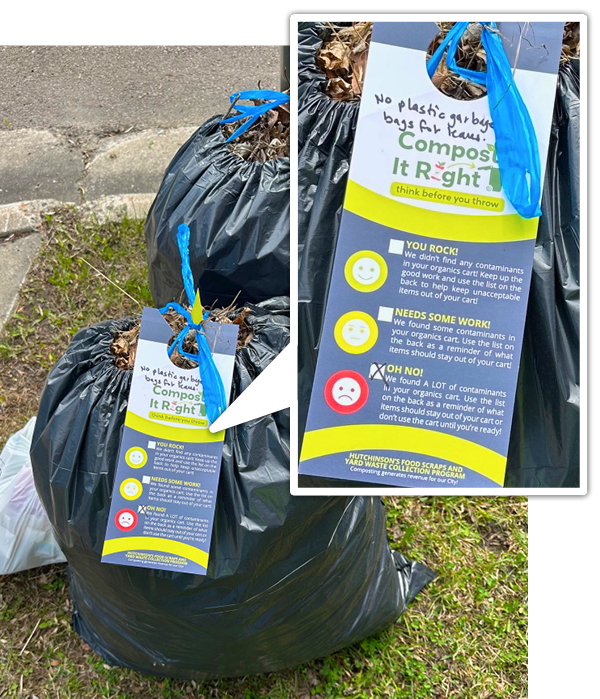
Cart tagging stood out as the most effective tool for correcting behavior. Items rejected include a handwritten note on the tag explaining why.
This wasn’t a one-and-done effort. Messaging and resident outreach was sustained over time, consistent across channels, and repeated in different formats so it would actually stick. As Cassandra Meuffels, Hutchinson’s Outreach and Education Coordinator, put it: “When it comes to proper waste sorting, residents are looking for guidance and often need many reminders. Messages have to be frequent and consistent. You can’t just run a one-year program and call it done.”
While all these approaches worked together to reinforce awareness, cart tagging stood out as the most effective tool for correcting behavior — especially among residents who supported the program but had not looked closely at the updated dos and don’ts to fine-tune their habits.
3. Pair education with enforcement.
A purely educational approach often falls short when contamination habits are entrenched. Hutchinson paired its outreach with a “two strikes and you’re out” policy:
- First strike: Residents were contacted after contamination was found, given specific feedback, and asked to review acceptable items in the Organics Cart Guide.
- Second strike: If contamination persisted, the cart was removed. Residents were then invited to tour the Creekside facility to see firsthand how curbside organics are processed into compost — and to understand why it’s crucial to include only compostable materials. If a resident completed the compost facility tour and demonstrated an understanding of how contamination harms the process, their cart was reinstated.
The message was simple: if you can’t or won’t use the cart correctly, please don’t use it at all. That might sound severe, but removing persistently contaminated carts can protect a program for everyone else.
4. Build contamination protocols into hauler contracts.
One of the biggest operational lessons from Hutchinson is the need to formalize the hauler’s role in contamination reduction. The first priority of haulers will always be efficiently finishing the route. Without contractual requirements, contamination oversight will not be their concern.
Municipalities should:
- Require haulers to tag contaminated carts
- Mandate that set out rates and cart contamination reporting is provided on a weekly basis to the city
- Require haulers provide organics carts in more than one size and in a different color than trash and recycling carts
- Require haulers provide frequent training to drivers (to account for staff turnover) on identifying and documenting contamination
Meuffels’ persistence and strong working relationship with Hutchinson’s hauler made these practices possible prior to modifying the contract, but the best insurance is putting these practices in writing.
5. Recognize the variables — and work around them.
Even the best-designed audit or outreach plan has to contend with real-world limitations. Hutchinson’s experience highlighted several challenges and how to deal with them:
- Staff turnover: New auditors from one year to the next may have different interpretations of what’s compostable. Clear, written guidelines with visual examples help.
- Seasonal shifts: Yard trimmings-heavy seasons or post-holiday periods can skew contamination rates. Schedule the annual or bi-annual audit accordingly.
- Operational limits: Tagging every cart on every route, every week, isn’t feasible without more staff. Create a plan for multiple cart tagging dates per year, work with community volunteers, and use social media to amplify each cart-tagging day.
Knowing these variables up front enables planning more realistic schedules and setting expectations with leadership.
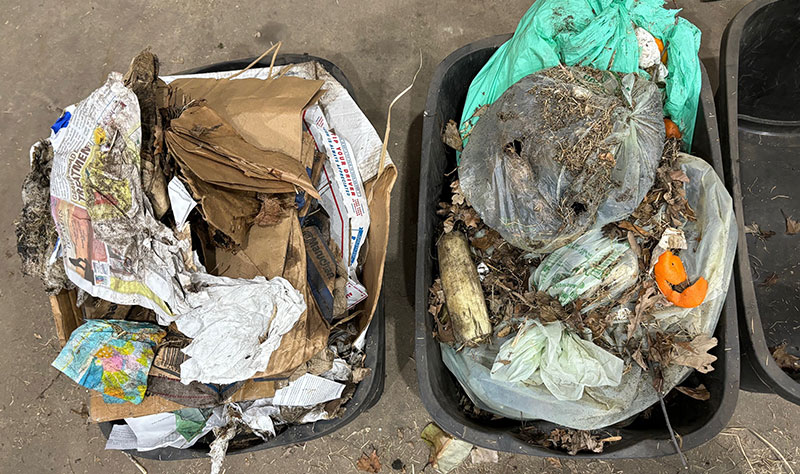
During audits, material was hand-sorted into categories — hard plastics, film plastics, glass, metals, rocks/bricks, large wood, yard trimmings, food waste, and other compostables. Sorted paper (left), and food scraps and compostable packaging (right).
6. Leadership buy-in is non-negotiable.
A contamination reduction program won’t succeed without support from decision-makers. Leadership needs to understand that sustained outreach and enforcement take resources — and that the payoff is program longevity, reduced processing costs, and higher-quality compost.
In Hutchinson, City and facility leadership backed the program, allowing Meuffels to spend time in the community, coordinate with haulers, and keep messaging in front of residents. It also gave Meuffels the time to implement new, innovative outreach ideas such as Hutchinson’s first “Plate to Garden” event, and team with community leaders.
7. Measure throughout.
Monitoring and evaluation are the backbone to every strong program. Hutchinson’s team integrated measurement throughout the three-year grant period as a way to check the effect of its “Compost It Right!” program. Measurement included:
- Baseline, mid-course and final audits to check progress
- Compost quality tests to see the effect of contamination reduction in the end product
- Surveys and focus groups with participants and non-participants to identify barriers, misconceptions, and growth in awareness
This approach allowed for quick course corrections such as shifting messaging when the data showed residents were misunderstanding, as well as validating which strategies were worth repeating.
Results and Perspective
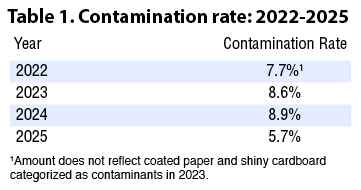 From 2022 to 2025, Hutchinson’s contamination rates declined (Table 1). But the numbers on paper don’t tell the whole story, since the list of accepted items changed during that period. For example, shiny cardboard and some coated paper products were deemed compostable in 2022 but stopped being accepted in 2023 due to PFAS concerns. Adjusted for those changes, contamination in 2022 was likely closer to 10% to 12%.
From 2022 to 2025, Hutchinson’s contamination rates declined (Table 1). But the numbers on paper don’t tell the whole story, since the list of accepted items changed during that period. For example, shiny cardboard and some coated paper products were deemed compostable in 2022 but stopped being accepted in 2023 due to PFAS concerns. Adjusted for those changes, contamination in 2022 was likely closer to 10% to 12%.
But the real success is that the City reversed a negative trend and built a framework for continuous improvement. Hutchinson knows that “Compost It Right!” does not have a program end date. For organics contamination to continue to decrease, residents will continue to need to be reminded and see the benefits of the reduction. Hutchinson has created a program that now has a clearer picture of problem materials and a system for identifying and addressing issues before they spiral.
Takeaways For Other Municipalities
Hutchinson’s journey offers a practical blueprint:
- Audit early and often. Get baseline data and track changes over time. Even imperfect audits are better than flying blind.
- Target your messaging. Focus on the top contaminants and repeat the message across multiple channels.
- Pair education with enforcement. Clear consequences protect program quality.
- Engage your hauler as a partner. And make that partnership contractual.
- Plan for variables. Build flexibility into audit schedules and outreach.
- Secure leadership support. Contamination reduction is a long game, not a quick fix.
- Keep talking to residents. Surveys and in-person conversations reveal barriers you won’t spot from the sorting floor.
At Amplify, we’ve seen the same pattern in city after city: programs that align design, operations, and communication from the start are the ones that thrive. Hutchinson’s experience reinforces that you can’t treat contamination as a side issue — it’s a core measure of program health and therefore the success of a program.
If your carts are coming in clean, it’s because the system that supports them is working. And if they’re not, the fix isn’t just a new flyer or a social media post — it’s a coordinated, data-driven effort that brings residents, haulers, and city staff into the same conversation.
Betsy Lipson and Mimi Shah, principals at Amplify for Change (Amplify), bring over 25 years of experience designing, leading and evaluating outreach campaigns, including ones that support solid waste and recycling goals, through practical, community-centered strategies. Amplify has worked with local governments across the country to increase participation in food scraps collection and reduce contamination in organics programs — whether through short-term pilots or full-scale citywide rollouts. Research tools like surveys and focus groups are used to tailor messaging and outreach approaches for a variety of audiences that work for real-world municipal settings. By helping cities and counties improve collection quality and build long-term engagement, Amplify’s work supports the operational and policy goals of public works and solid waste departments alike.


